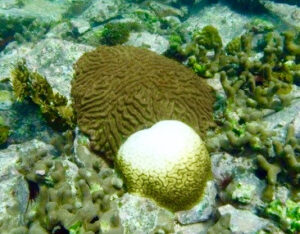
Prolonged, exceptionally warm temperatures have caused the fourth ever global coral bleaching event — a likely precursor to yet more massive loss of the world’s coral reefs.
The announcement came as a joint statement Monday from The International Coral Reef Initiative and the U.S. National Oceanic and Atmospheric Administration.
Given reports over the last few months of bleaching events in various regions — including in Virgin Islands waters — the report was not totally surprising, but nevertheless its seriousness made headlines across the country.
Even more concerning than the statement about the current bleaching status, is the prediction that there is more to come this summer, as sea water temperatures continue to rise.
Bleaching occurs when corals lose the algae that lives within them, giving them color and nutrients. It is generally triggered by overly warm waters. If the water temperature returns quickly to normal, the corals can recover, but if the event is prolonged, the corals are weakened and may eventually die.
A massive bleaching event in the Caribbean in 2005 resulted in the loss of more than half of what was then the coral population in V.I. waters.
Periodic bleaching events in limited areas are indicative of natural cycles, but worldwide bleaching is attributed to global warming.
The last 12 months have been the warmest on record, and sea temperatures have mirrored the rise in air temperatures.
In the past year, more than half of the world’s reef areas have seen coral bleaching, according to the joint report. That includes reefs near 53 countries and territories throughout the waters that are home to reefs — the Atlantic, the Pacific, and the Indian Oceans.
The first global bleaching event recognized by scientists was in 1998. The second was in 2010, and the third occurred from 2014-2017. A NOAA official was quoted in a CNN report saying it’s likely this event will surpass all of them in severity, as the area experiencing bleaching-level temperatures continues to expand at a rate of about one percent per week.
In the Virgin Islands, researchers are still assessing the damage from the 2023 summer bleaching event. University of the Virgin Islands Professor Tyler Smith, who is also the territory’s director of coral reef monitoring, said they have completed field work in St. Croix waters and are currently surveying St. Thomas-St. John reefs.
Some species seem to have been hit especially hard, he said. In some areas, so-called lettuce corals have been reduced in numbers of around 80 to just one or two, or even wiped out completely.
Star corals, which Smith described as “the main reef formers” in V.I. waters, may not have been damaged as badly as they were in 2005, but “you can see mortality out there.”It will be sometime this summer before anything like an official assessment of the damage is available, he said. That will take reviewing video and a lot of serious number crunching.
Looking to the future, the picture is also grim.
The water temperature in the territory is currently 1.3 degrees Celsius higher than normal for this time of year, Smith said. It is the highest recorded for this time of year.
“We’re really worrying about a back-to-back bleaching event this year,” he said
In the next nine to 12 weeks, NOAA predicts the territory will be in a “watch” for an event, he said. By August — typically the most likely time for bleaching — conditions will really be ripe.
Corals face numerous dangers besides bleaching. Scientists estimate that since the 1970s, reefs in Virgin Islands waters have declined between 50 percent and 80 percent. That has devasting consequences for the marine ecosystem.


